Best tips and tricks for improving a cheap electric guitar

This guide of the best tips, tips and tricks to improve or upgrade a cheap, entry-level or low cost guitar, will allow you to get the best out of your instrument, improving its playability, versatility and tone. It is designed for beginners who want to improve or upgrade their first guitar and also for any guitarist who is looking for an affordable and economical electric guitar or for that restless spirit that seeks to experiment with modifications in a musical instrument.
Is it worth improving or upgrading your entry-level guitar?
Today the quality of guitars for beginners is far superior to what they were a few decades ago. In fact there are models that sound great, you can see our note of the best low-cost electric guitars with instruments that have great value for the money.
But like everything in life, sometimes expensive guitars don’t sound good, imagine a Low Cost guitar. While you can find some guitars that sound and perform great, there are also some that sound and perform poorly. It is important that you analyze this before embarking on a major upgrade or tuning. If you are lucky enough to have a good low cost guitar, this guide is perfect for you.
In addition, the upgrade process will allow you to better understand your instrument and learn how the guitar and its different components work, and the influence that each one has on the tone, playability and intonation. A good starting point is the guide to the parts of the guitar and their importance in tone.
Finally, beyond the upgrades or improvements that you make to your instrument, there are tricks to get the best tone from your guitar, also consider them to obtain the best possible sound.
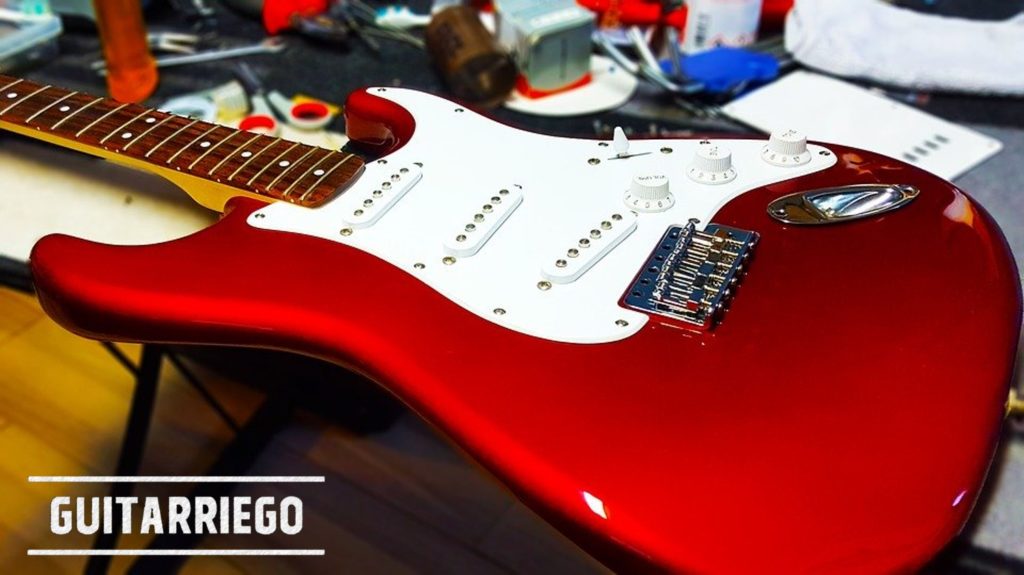
The best 7 tips to improve your Entry-Level guitar
We will review the main and most important changes, but not the only ones. The guitar has endless options for adjustment and improvement.
What are the best tips to improve or upgrade your cheap guitar?
Best tips to upgrade or improve a cheap guitar:
- Change the pickups or pickups of your guitar
- Improve the nut of your guitar
- Guitar Bridge Upgrade
- Pin changes
- Improve Output Jack
- Replaces electronics: Potentiometers and Selector switch
- Calibrate the instrument with a trusted luthier
Next, we develop each of the points.
Change the pickups or pickups of your guitar
Without a doubt the first upgrade is the change of pads or pickups. The reasons are that it is probably the improvement that will most influence the tone of your instrument; It is easy to do; It allows you to customize the audio and, furthermore, if you ever sell the instrument, you can easily uninstall them and sell them separately in the used market, being able to recoup a large part of the investment. The latter does not happen with almost any of the other options. That is why we consider it one of the most important tips to improve the tone of your guitar.
The options for guitar pickups that you can find on the market are practically endless. Depending on your budget or the instrument you have, you can invest in cheap pickups with an excellent price-quality ratio, or go to recognized brands in the market with high quality standards such as Seymour Duncan or DiMarzio.
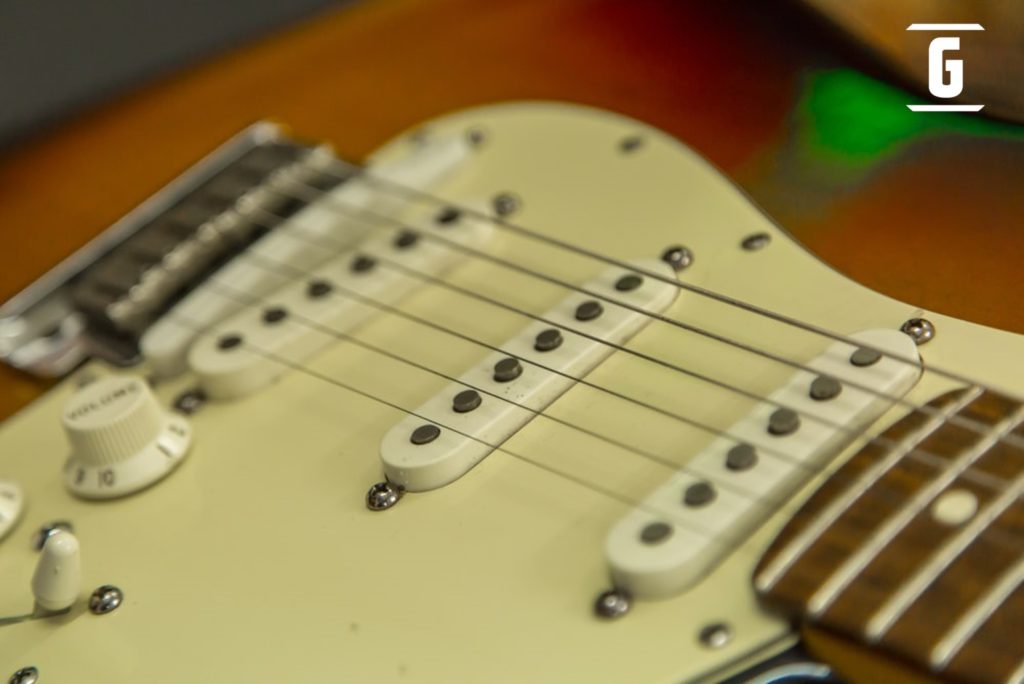
Alnico Pickups: More Audio Clarity and Warmth
Inexpensive guitar pickups typically have ceramic magnets, which sound sharp and aggressive, with little dynamics. Almost any Alnico pickup on the market will give you more audio quality, clarity and warmth.
Important clarification, ceramic pickups are not always bad. There are ceramic pickups that are of excellent quality, they are normally used in humbuckers for heavy styles such as heavy metal.
Within the range of inexpensive pads you can find the Wilkinson, which have an excellent price-quality ratio. Be careful not to buy the ceramics, be sure to buy the Alnico ones, they are a bit more expensive, but they are the ones that will really enhance your tone. You can also check with a local pickup manufacturer for good prices and quality.
If you have a loose budget or have a guitar that is closer to the Mid-Level range such as a Squier Stratocaster or Telecaster Classic Vibe, an Epiphone Les Paul Standard or an Ibanez AS-73, just to give a few examples, a few High-quality pickups are an excellent option. DiMarzio or Seymour Duncan have a great variety of pickups for all tastes, they also have guides so you know which model best suits your tastes. Don’t forget to always consider your local manufacturers as an option in this case as well.
Improve the nut of your guitar
The nut, often ignored, is a fundamental part of the instrument, not because of the change in tone, although it does influence, but because of the effect on the tuning and intonation of the instrument.
The nut is a part where the string has more friction, when bending the string or when using the tremolo, the string moves and if the nut is not good or is not set correctly, it does not slide well and does not return into place correctly, causing you to constantly go out of tune. It is very common to criticize the tuning pegs for tuning issues, but usually the responsible for these problems are the nuts.
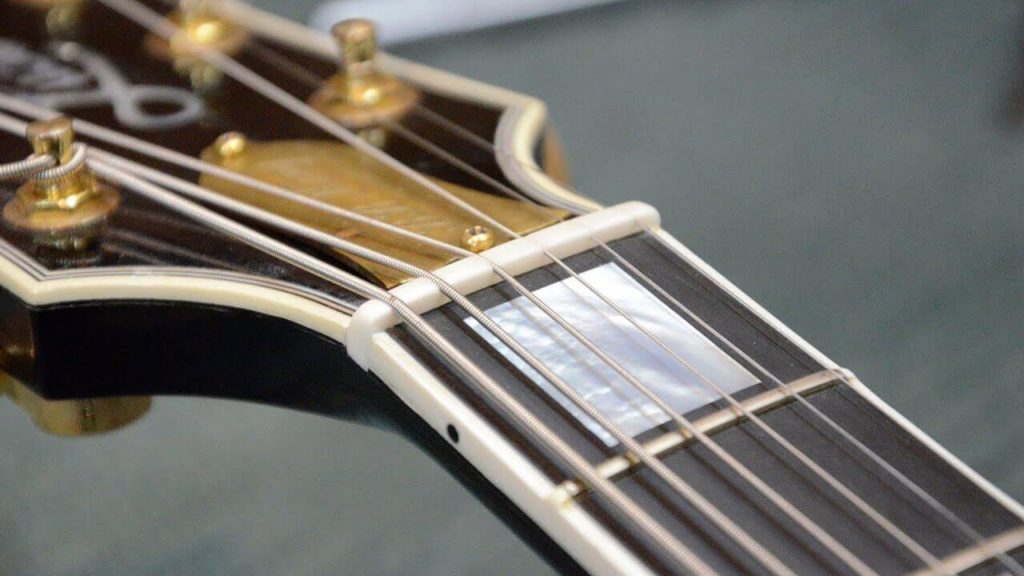
Nut lubrication
In case you cannot make a nut change for whatever reason, a suggestion we make is that you lubricate it. You can lubricate it with graphite, either with graphite powder or with the lead of a pencil. Also make sure that the channel the string passes through is smooth and has no rough edges that will cause the string to not run smoothly.
Guitar Bridge Upgrade
While this is true for any guitar, it is especially important on a Stratocaster. This is because cheap guitars, even Mexico’s Fender Stratocaster Standard, come with the fine tremolo block. Low mass blocks cause the guitar to lose shine, attack and sustain.
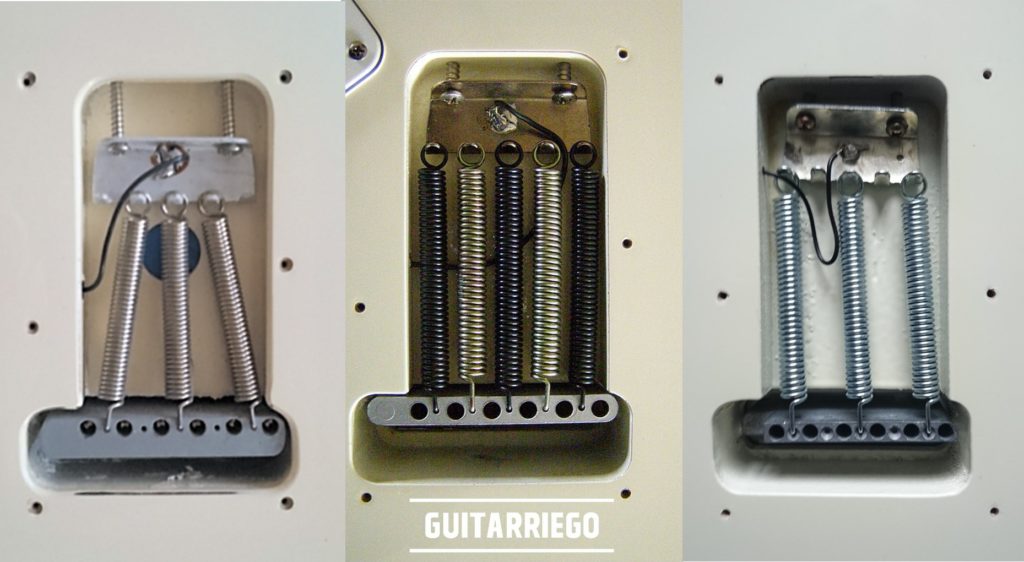
Tremolo Block Shift
One option is to simply change the block, but it surely requires a custom construction, since there is no standard in the measurements and location of the screws with which the block is fixed. We do not suggest this, as the cost of the custom build will be more expensive, and you will lose the option to upgrade the entire bridge, plate, saddles and lever anchor.
A new tremolo bridge
The best option in our opinion is to buy a new bridge. Keep in mind that there are two types of measurements, the narrow bridges with 52.5 mm or 2 1/16 inches and the standards of 56 mm or 2 1/16 inches, which is the width of the saddles and the anchor bolts.
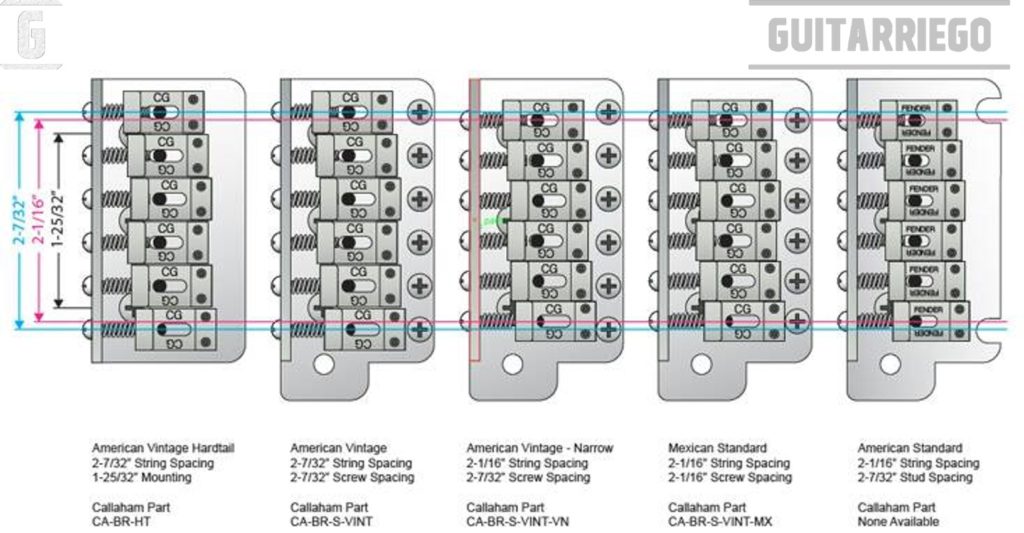
What materials of the blocks of the Stratocaster tremolos?
The most common materials are steel and bronze. The general opinion is that a brass block sounds warmer while a steel block has more sustain. Another not so traditional material, newer in its use, is aluminum, which can weigh almost a third of one of steel. The most popular type of the latter is aeronautical aluminum for its hardness.
In case you have a guitar with a certain quality as mentioned above, you may want to consider the material of the block. But we clarify that, with a thick block it will be enough improvement for a low cost guitar. The difference in the material will not be significant in tone, but it can have it in the price.
How much does the tremolo block on the bridge of a Strat weigh?
The approximate weight of a Stratocaster block, depending on the material, is as follows:
- Aluminum: 3.36 ounces / 95 grams *
- Steel: 10.72 ounces / 304 grams *
- Bronze: 9.76 ounces / 277 grams *
* Source: Kluson Blocks
In all cases, we recommend purchasing the steel block Wilkinson bridge. It is a barbaric and cheap option with excellent value for money. There are more expensive and better, but the audio difference will be minimal. In case you consider the weight of the instrument really important, consider an aluminum block.
Pin changes
We suggest this change if you really feel that they are not working well. For example, if they have play that does not allow you enough precision to tune correctly. As we explained earlier, there is a belief that most tuning problems are the pegs, when the nut is usually the main drawback.
As with the bridge, you must consider the measurements. There are different types, make sure to measure the hole and the distance between the pins correctly before buying a new set.
Lighter machine heads, better guitar performance
If you have the possibility to compare between two similar pegs, choose the one with the lowest weight. Paul Reed Smith, luthier and owner of PRS Guitars, ensures that the lighter the pegs, the more resonance the instrument has.
In case you finally decide to upgrade, Gotoh Vintage tuners are a great option.

Improve Output Jack
Sooner or later, almost every inexpensive guitar has problems with its Jack. It is a common problem point -especially in Stratocaster- that generates false contacts, noise and loss of tone or directly cut off the sound. Therefore, changing the jack is one of the tips to improve your guitar.
Stratos jacks are notorious for loosening and frequent tightening usually ends up causing kinked wires and deteriorated solder joints or simply disconnected. The solution may simply be to put in new, better quality nuts and washers that won’t loosen.
Vintage-style Telecaster jacks are sensitive to the inevitable accidental pulling of the cable. There is a jack -or jack plate- that is screwed to the body and gives greater stability and resistance.
Replaces electronics: Potentiometers and Selector Switch
Cheap guitars often have electronic problems due to the low quality of their components. They usually have noise or audio degradation drawbacks when using them.
Alpha potentiometers are inexpensive, about $ 1 each. Therefore, the greatest effort goes through its installation, but if you know how to weld, you know that it is something simple. Although it is not an essential improvement, because of its cost, do not hesitate to change them, not only will you avoid future headaches with noise later, depending on the quality of the originals, you can allow them to be used since they better preserve the tone of the instrument.

Selector switchs can be a bit more expensive, depending on the type and brand. But low quality originals can also be problematic with false contacts and / or noise. You can try cleaning them before changing them, but if you prefer to make the change, it will be a nice improvement.
Take the opportunity to make these changes when you change the pickups.
Calibrate the instrument with a trusted luthier
If an instrument is not properly calibrated and set up, the above tips to upgrade or improve your guitar will lose their effectiveness and you will never achieve a good tone or comfort when playing. So this is not only very important, but also the basics.
Guitarists, especially beginners, often ignore the importance of a good instrument calibration. This not only improves tuning and intonation, it also affects the comfort and tone of the instrument.
Many believe that the intonation of the instrument is adjusted with a simple fifth or octave, which can be done simply with a tuner and a screwdriver. But the curve of the neck, the adjustment of the nut and the height of the strings have a very important impact not only on the tuning, but also on the comfort of the guitar and its tone.
Does each story calibrate the instrument?
That depends on the instrument, the guitarist and where you live. There are instruments that have good stability, and are not significantly affected by changes in humidity or temperature. On the other hand, there are others that are affected. Depending on the instrument, it is recommended to do this at least every 6 months, with each change of season for a sensitive instrument whose guitar wood expands and contracts easily. While an instrument with good stability, an annual review will be more than enough.
Your playing style also affects, if you are a guitarist looking to have a low action – string height near the fretboard – you probably need to send your guitar to tune more often.

Finally, where you live will also affect. As we explained, changes in temperature and humidity affect the wood that expands and contracts. If these changes are marked, you will need to send the instrument to be calibrated more frequently.
Finally, send your guitar to a trusted luthier. It is full of guitarists who tune their own guitars themselves and believe they do it well, and offer their luthier services. Not only will they not leave the instrument properly adjusted, they could also damage your instrument through malpractice. Therefore, before leaving your beloved guitar to someone, investigate their experience and quality as a luthier.
Related Articles: Parts of the electric guitar and importance of each.
For more information and other tips, head over to Guitar Quarter.
You can share opinions or also chat about this and more with other musicians in our comments section.






